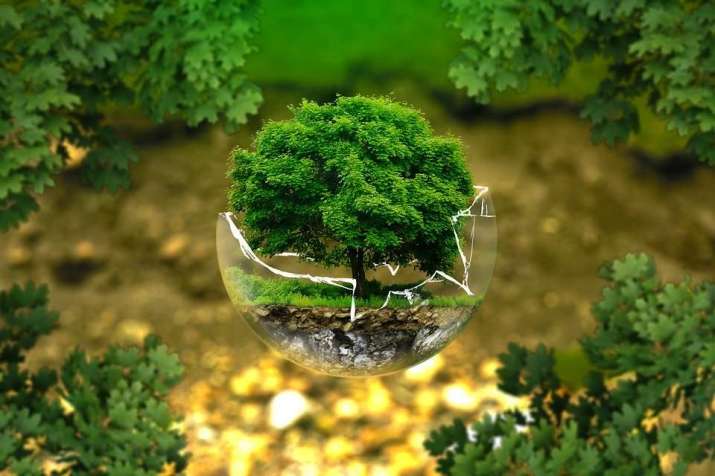
The Pali scholar Lily de Silva once wrote:
Man in his search for pleasure and affluence has exploited nature without moral restraint to the point that nature has been rendered almost incapable of sustaining healthy life.*
Professor de Silva, who knew the Tipitaka inside out and backwards, has pointed out that while the Buddha limited his teaching to the eradication of human suffering, it is still possible to find enough references to nature within the Pali Canon to suggest a Buddhist attitude toward the environment. In this essay, we shall paraphrase some of the main points in précis form:
Invaluable gifts of nature, such as air and water, have been polluted with disastrous consequences, and humans are seeking ways and means of overcoming pollution because even our own health is now threatened.
We know it is morally wrong to commit future generations to a polluted planet. If we are to act with responsibility toward the natural world, to our fellow human beings, and unborn generations, we must establish an environmental ethic to prevent aggravation of the pollution problem.
The word “nature” denotes everything extant in the world not organized and constructed by man. The Pali terms closest to “nature” are loka and yatha-bhuta. The former can be translated as “world,” while the latter means “things as they really are.” The words dhammata and niyama in the Pali Canon mean “natural law.”
Changeability is one of the perennial principles of nature. Everything in nature is subject to change and nothing remains static. This is expressed by the Pali term anicca. Everything formed is in a constant process of change (sabbe saòkhaaraa aniccaa). (A.IV.100)
The world can be defined as that which disintegrates (lujjati ti loko). It is dynamic and kinetic. It is constantly in a process of undergoing change. (S.IV.52) In nature there are no stable “phenomena,” only ever-changing processes.
Rain illustrates the point. Although we use the word “rain” to denote a “thing,” rain is actually a process of drops of water falling from the skies. Apart from this process, no rain exists as a static concept.
The elements of solidity (pa thavii), liquidity (aapo), heat (tejo), and mobility (vaayo), the building materials of nature are similarly ever-changing phenomena. Even solid-looking mountains and the Earth that supports them are controlled by the inexorable law of change.
Mount Sineru—which is rooted in the great ocean to a depth of 84,000 leagues; which rises above sea level to a great height of 84,000 leagues; the classical symbol of stability—is destroyed by heat following the appearance of multiple suns, leaving only ashes. (A.IV.100)
The world passes through alternating cycles of evolution and dissolution, each of which endures for a long period. Change is not only inherent in nature but also in the morals and actions of man.
According to the Aggañña Sutta, (D.III.80) concerning the evolution of the world, the appearance of greed in primordial beings—who were self-luminous, subsisted on joy, and traversed the skies—caused a subsequent loss of radiance and a loss of the ability to subsist on joy and move through the sky.
Moral degradation also affects the external environment. At first, the Earth was covered with a flavorsome, fragrant substance similar to butter; however, when beings began partaking more and more greedily of this substance, their subtle bodies became more and more coarse, while the flavorsome substance began diminishing.
With the solidification of bodies, differences in form appeared. Some were beautiful while others were not, causing conceit to manifest, causing the beautiful ones to look down on the others, and because of such moral blemishes, the delicious edible earth-substance disappeared completely.
In its place, edible mushrooms appeared, and later a kind of edible creeper. Among the beings who subsisted on them, sex differentiation became more and more manifest and the former method of spontaneous birth was replaced by sexual reproduction.
Self-growing rice appeared on Earth and man, through laziness to collect each meal, began hoarding food. As a result of hoarding, the growth rate of food was unable to keep pace with demand and land had to be divided among families. After private ownership of land became common, those who were greedy began robbing others’ land, and when caught, they lied and denied they had stolen. Through such greed, vices such as stealing and lying became manifest. To curb and punish wrongdoers, a king was elected and society became more complicated.

The moral degeneration of humans had adverse affects on nature. The richness of the Earth diminished until self-growing rice disappeared. Man then had to till the land to cultivate rice, which was enveloped in chaff and needed cleaning before cooking. Change was inherent in nature, but man’s moral deterioration accelerated more changes in nature, which were adverse to human well-being and happiness.
The Cakkavattisiihanaada Sutta predicts the future, as humans undergo further degeneration. (D.III.7). Human health will gradually deteriorate and life expectancy will diminish, with the average lifespan being reduced to 10 years and the marriageable age to five years. When this happens, delicacies such as ghee, butter, and honey, will disappear, and the coarsest food of yesterday will become the delicacy of today.
Buddhism maintains that there is a close link between morals and human access to natural resources. When profligate lust, wanton greed, and wrong values grip the human heart and immorality becomes widespread, then rain will fail to fall. When rain fails to fall, crops will be affected by pests and plant diseases, and through a lack of nourishment, the death rate will rise. (A.I.160.9)
Moreover, an environment conditions the development of its flora and fauna. These in turn influence and counteract in the thought patterns of the people. Human morals influence not only the psychological makeup but also the biological environment of the region. These laws demonstrate that humans and nature are bound together in a causal, reciprocal relationship, with changes in one bringing about changes in the other.
The commentary on the Cakkavattisiihanaada Sutta explains this mutual interaction further. (Dhp-a III.854) When mankind becomes demoralized through greed, famine is the outcome. When moral degeneration is due to ignorance, epidemics result. When hatred is the demoralizing force, widespread violence is the outcome. If and when mankind realizes that large-scale devastation has taken place because of his moral degeneration, a change of heart will then take place among those few human beings who survive.
With gradual moral regeneration, over a long period, conditions will improve and mankind will start enjoying more prosperity and longer life. Thus the world, including nature and mankind, stands or falls based on moral force. If immorality grips society, man and nature deteriorate. If morality reigns, the quality of human life and nature becomes better.
Greed, hatred, and delusion produce pollution within the mind and in society, while generosity, compassion, and wisdom, on the other hand, generate purity both within the mind and the environment.
* See introduction essay in “The Buddhist Attitude Towards Nature” (p.19) by de Silva, Lily, in Sandell, Klas (ed.), 1987. Buddhist Perspectives on the Ecocrisis.
References
Sandell, Klas (ed.). 1987. Buddhist Perspectives on the Ecocrisis. Kandy: Buddhist Publication Society.












